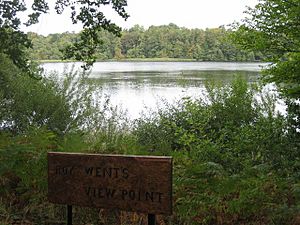Cop Mere facts for kids
| Site of Special Scientific Interest | |
 |
|
| Area of Search | Staffordshire |
|---|---|
| Coordinates | 52°51′54″N 2°17′41″W / 52.86487°N 2.29481°W |
| Interest | Biological |
| Area | 93.4 acres (0.3780 km2; 0.1459 sq mi) |
| Notification | 1968 |
Cop Mere is one of the biggest natural lakes or ponds in Staffordshire, England. It covers about 42 acres (17 hectares) of water. This special place has been named a SSSI since 1968.
Being an SSSI means it's a protected area. Cop Mere is important because it's a type of wetland called an "oligotrophic mire." This means it has very low nutrients, which allows special plants like Sphagnum moss to grow. Many rare plants and animals also live here, making it a unique natural habitat.
Contents
How Cop Mere Was Formed
Cop Mere was created a very long time ago, around 200 million years ago. It formed in a hollow in the Keuper marl, which is a type of soft rock and soil found in North Staffordshire. This hollow was left behind when the last ice age ended and the huge glaciers melted away.
What makes Cop Mere different from other ponds nearby is that the River Sow flows through it. The river's movement helps tiny algae grow. These algae are important for the freshwater mosses that thrive here.
A Special Environment for Wildlife
Humans have also played a part in shaping Cop Mere. Around the year 1250, a dam was built upstream at Jackson's Coppice and Marsh. This changed how the River Sow flowed into the mere. This man-made change created an even more unique environment. It has become a perfect home for many different kinds of birds and fish.
People have been fishing in Cop Mere for a very long time. Records show that fishing here dates back to the time of King Henry VIII. Scientists who study insects, called entomologists, have found two rare types of beetles and two rare types of flyes living around the mere.
Rare Plants and Birds
The SSSI area around Cop Mere is home to several plants that are quite rare in Staffordshire. These include the interesting herb paris (Paris quadrifolia) and a thin-spiked plant called Carex strigosa.
Many different birds love to visit or live at Cop Mere. You might spot reed warblers and sedge warblers, which are small birds known for their songs. Larger water birds like the great crested grebe and the little grebe can also be seen on the water. In the trees, you might see a sparrowhawk hunting. There are also three kinds of woodpeckers, including the small lesser spotted woodpecker.
Fishing at Cop Mere
Cop Mere is a popular spot for coarse fishing. This type of fishing involves catching freshwater fish that are not usually eaten. The mere is famous because the British record for the biggest common bream caught with a rod has been set here twice!
Today, the main fish that anglers try to catch is the tench. But the mere is also home to other fish like perch, roach, and large pike.

